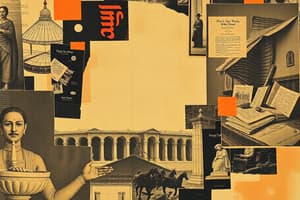Podcast
Questions and Answers
Who are some notable writers in Hindi literature?
Who are some notable writers in Hindi literature?
Munshi Premchand, Rabindranath Tagore, Mulk Raj Anand
What are two well-known epics in Hindi literature?
What are two well-known epics in Hindi literature?
Mahabharata and Ramayana
What do folktales and fables in Hindi literature often emphasize?
What do folktales and fables in Hindi literature often emphasize?
Human virtues and vices
Name a famous Hindi dramatist and one of their works.
Name a famous Hindi dramatist and one of their works.
Which Hindi novelist focused on social realism in their work?
Which Hindi novelist focused on social realism in their work?
What genres are covered in Hindi literature besides novels?
What genres are covered in Hindi literature besides novels?
What are some of the genres found in Hindi literature?
What are some of the genres found in Hindi literature?
Which ancient epics influenced the origin of Hindi literature?
Which ancient epics influenced the origin of Hindi literature?
During which period can Hindi literature be traced back to?
During which period can Hindi literature be traced back to?
Who rewrote the famous epic Ramcharitmanas in the Avadhi dialect?
Who rewrote the famous epic Ramcharitmanas in the Avadhi dialect?
Which poets played a significant role in shaping Hindi literature during the medieval period?
Which poets played a significant role in shaping Hindi literature during the medieval period?
Under whose patronage did Hindi literature flourish during the medieval period?
Under whose patronage did Hindi literature flourish during the medieval period?
Flashcards are hidden until you start studying
Study Notes
Introduction to Hindi Literature
Hindi literature refers to creative literature written in the Hindi language. With over 50 million books published in Hindi every year, it is one of the most prolific publishing industries worldwide. Hindi literature has originated from the ancient epics like Mahabharata and Ramayana and has continued to grow with various genres such as poetry, novels, short stories, plays, essays, and more. In this article, we will explore different aspects of Hindi literature, including its history, forms, popular literary figures, and notable works.
History of Hindi Literature
Hindi literature can be traced back to the Vedic period (approximately 1500 BCE - 500 CE), where texts were composed in Sanskrit, a classical language that heavily influenced Hindi's development. By the 9th century CE, Prakrit languages like Pali and Apabhramsa began to emerge, eventually leading to the emergence of early Hindi literature. Some of the early works in these languages include the Avadhani poems and the first draft of the famous epic Ramcharitmanas, which was later rewritten by Tulsidas in Avadhi dialect.
During the medieval period, Hindi literature flourished under the patronage of royal courts across North India. Poets like Amir Khusro, Kabir, Mirza Ghalib, and Bhagat Surdas played a significant role in shaping the genre during this time. Their works often reflected the social, religious, and political changes happening within their communities.
In the modern era, Hindi literature experienced significant growth with influences from English and regional languages. Notable writers like Munshi Premchand, Rabindranath Tagore, and Mulk Raj Anand contributed to the evolution of the genre through their unique styles and themes. Today, Hindi literature continues to evolve, incorporating contemporary issues and diverse voices.
Forms of Hindi Literature
Epic Poetry
Epics are lengthy narrative poems that recount historical events, mythological tales, and moral teachings. Two of the most well-known epics in Hindi literature are Mahabharata and Ramayana. Although they were originally written in Sanskrit, many versions have been translated into Hindi. These epics continue to inspire new generations of readers and form the foundation of Hindu philosophy and values.
Folktales and Fables
Folktales and fables are short narratives that impart moral and cultural lessons. They often feature animal characters and emphasize human virtues and vices. Popular folktales in Hindi literature include those featuring Panchatantra animals, the Jataka tales, and the collection known as Hitopadesha or Here Today Gone Tomorrow. These stories have been passed down through generations and continue to entertain and educate audiences today.
Drama and Plays
Drama and plays are an essential part of Hindi literature, showcasing various aspects of Indian society and culture. Works such as Savitri Satyanarayan Pariksha, by Okakar, and Andhere Mein Chandni Rati Hai, by Girish Ghosh, demonstrate the depth and breadth of Hindi drama. Many playwrights also incorporate elements of music, dance, and theater traditions, making them engaging performances.
Novels, Short Stories, and Essays
Novels, short stories, and essays cover a wide range of topics, including social issues, love, friendship, and personal experiences. Some of the most renowned Hindi novelists include Munshi Premchand, whose work often focused on social realism; Kamal Hassan, who combines storytelling with visual arts; and Anuradha Roy, who explores complex relationships and societal norms. Short stories and essays, too, offer insights into everyday life and current affairs.
Conclusion
Hindi literature offers a rich tapestry of creativity, reflecting the diverse cultures, histories, and experiences of people living in the Hindi-speaking regions. From epic poetry to modern novels and screenplays, there is something for everyone in the vast world of Hindi literature. As the language itself continues to evolve, so does its accompanying body of work, ensuring that Hindi literature remains a vibrant and relevant art form for years to come.
Studying That Suits You
Use AI to generate personalized quizzes and flashcards to suit your learning preferences.




